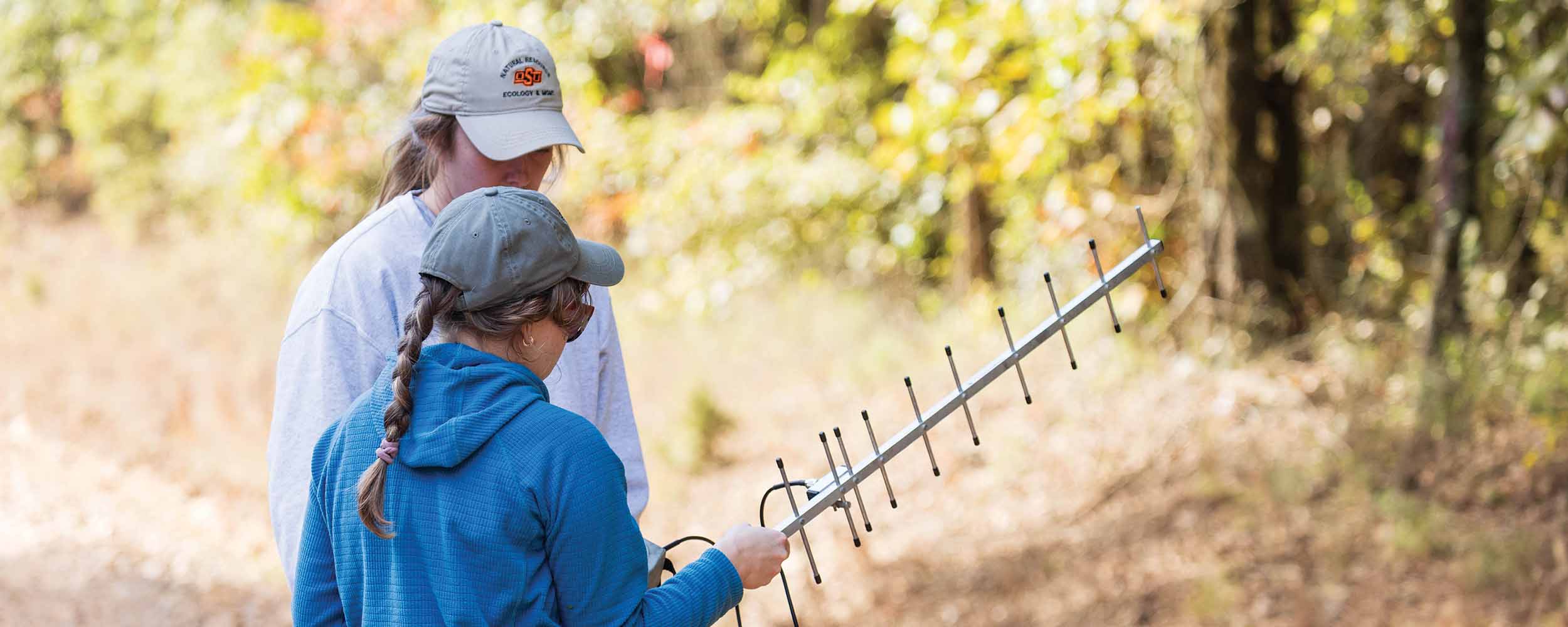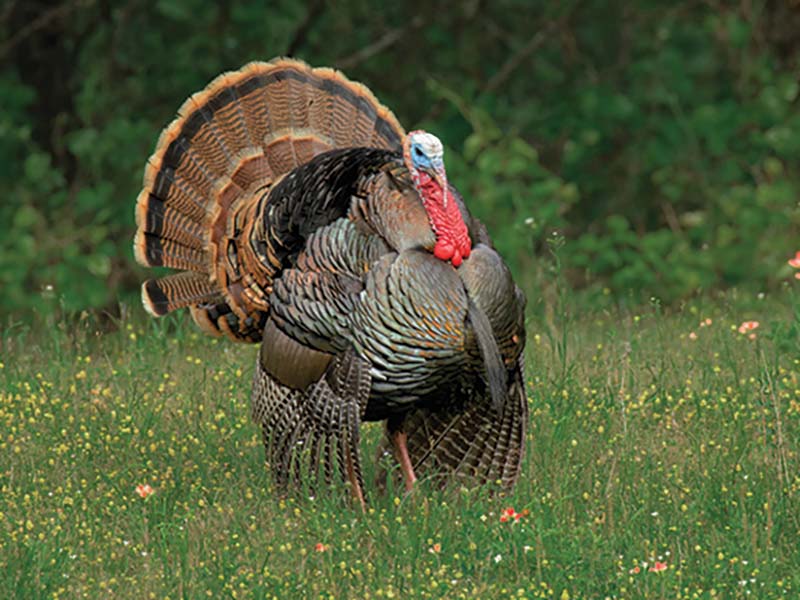
The Disappearing Game: Researching turkey decline
Wednesday, December 20, 2023
Media Contact: Sophia Fahleson | Digital Communications Specialist | 405-744-7063 | sophia.fahleson@okstate.edu
Six hours have now passed, and still, no movement. The dew fades, and the birds sing, but no turkeys appear.
Recent annual surveys from the Oklahoma Department of Wildlife Conservation suggest a decline in Oklahoma turkey populations, and observations made by wildlife enthusiasts confirm these results, said Kurt Kuklinski, ODWC wildlife diversity and research supervisor.
“For the last three to five years, we’ve started to see some declines in the turkey population,” Kuklinski said regarding recent annual surveys.
The results of the data were magnified when game wardens, biologists and hunters all began asking about the decline, Kuklinski said.
Because this problem was observed by many, ODWC officials decided to look deeper into the turkey population issue, he added.
To uncover the cause of the decline, the ODWC requested research proposals about Oklahoma’s turkey population, Kuklinski said.
“ODWC initially put out the request for proposals, and Oklahoma State University jumped on it,” said Cody Griffin, doctoral student in the OSU Department of Natural Resource Ecology and Management.
Faculty members created a proposal to study the turkey population in partnership with Texas A&M University-Kingsville, Griffin said.
In 2021, the proposal was accepted, and the research team began working with the ODWC to complete each part, said Dr. Colter Chitwood, OSU NREM assistant professor and lead principal investigator on the grant.
The wild turkey research team is comprised of faculty and students from OSU and TAMU-Kingsville.
Between the two universities, six faculty members and four graduate students are involved in the five-year project, Griffin said.
As the first student on the project, Nicolle De Filippo, OSU NREM master’s student, led the first wave of turkey captures in southeast Oklahoma, she said.
“In the late winter and early spring when turkeys are flocked together in their winter groups, we put out bait, take pictures and set up a capture site,” De Filippo said. “From the capture site, we’ll launch a rocket net and trap the turkeys underneath the net.”
Backpack transmitters then are placed on each turkey to monitor its behavior and survival in the environment, De Filippo added.
“Capturing turkeys is probably the hardest part of the project,” Griffin said. “We have different methods for capturing turkeys depending on the part of the state.”
In southwest Oklahoma, Griffin uses walk-in traps instead of rocket nets, he said. Although Eastern wild turkeys are hesitant to walk into traps, the Rio Grande turkey has no problem doing so, Griffin added.
The bait alone is placed in the traps while the turkeys get used to them, Griffin said. Then, after they are comfortable walking into the traps, funnels are inserted so the turkeys get stuck, he continued.
“Once the turkeys are caught, I do the same thing they’re doing in the southeast,” Griffin said. “I do morphometric measurements, collect blood samples and put on the transmitters.
“I enjoy the challenge of what we can do with the data we have as we really work to contribute to science.”
This year, as De Filippo finishes her master’s program, her research will be continued by Cyrena Bedoian, OSU NREM master’s student. She will focus on the predatory aspect of the project while continuing the research De Filippo was conducting, Bedoian said.
“I’ll be putting game cameras out to look at mammalian nest predators to see what the predator composition looks like on the landscape,” she added.
Right now, the goal is to gain a comprehensive understanding of the turkeys’ nesting behavior, reproductive success, and survival of different life stages to determine if a decline is occurring and, if so, what is causing it, De Filippo said.
“We’re collecting some of the best data ever collected on turkeys in Oklahoma,” Chitwood said. “Even though turkey research has been done in Oklahoma before, the technology has grown by leaps and bounds, so the information we can get now is an incredible advancement for the ODWC.
“It’s an important project on an important species at an important time,” Chitwood added.
During the five-year span, the project is expected to cost about $1.3 million with funds distributed annually based on projected budget needs, Chitwood said.
“The funding mechanism in these grant programs is a huge asset to wildlife management and wildlife research,” Kuklinski said.
With the funding provided by the ODWC, OSU can support most of the research costs, Chitwood said.
The ODWC funding can be allocated toward equipment, transportation, housing, and even salaries and tuition for the graduate students, Griffin said. Recently, the research team purchased new transmitters with grant funding.
With this new technology, the team can collect better data at a fraction of the cost, he added.
This grant benefits the university and students financially, Chitwood said. Two master’s students and two doctoral students are completing their graduate research requirements through this project.
“We wouldn’t be able to do these projects on our own,” Kuklinski said. “To address the turkey decline, we first need to know what’s causing it, and we don’t have the manpower and capacity to go out there and figure it out ourselves.”
With the funds provided by the grant, the NREM department can pay for the student training and field work to answer these questions, Chitwood said. It just makes sense for both parties involved, he added.
“The research being done is really on the backs of the students,” Griffin said. “We’re the vehicles for it.”
Even undergraduates have many ways to get involved in projects like this, Bedoian said. One of the best ways is to ask about opportunities or even volunteer to help with a project, she added.
“The more experience you have, the easier it will be for you to figure out what you like and what you don’t,” De Filippo said.
Before coming to OSU, Bedoian worked with Chitwood and other faculty members on a recent pronghorn research project, she said.
When she heard about the current research opportunity, knowing she would work with the same faculty members made coming to OSU an easy decision, Bedoian added.
“The opportunity to work with somebody I admired was awesome,” De Filippo said.
With the academic resources, student training and coursework available at OSU, this partnership creates a great solution for the ODWC, Chitwood said.
At the end of this project, the ODWC hopes the feedback from the research team will show them changes to implement in the turkey habitat, Kuklinski said.
“If there is a land management practice that would directly impact and benefit turkey nesting success, that’s like a silver bullet for us,” Kuklinski said. “That’s something we could immediately latch onto and broadly apply across a landscape for the betterment of the turkey population.”
The end goal is to look at the results and come up with the best solution, whether it be changing the land management practices or implementing a specific habitat management technique, Kuklinski said.
“Turkeys are such a beloved natural resource,” Bedoian said. “We want to do as much as we can to keep turkeys on the Oklahoma landscape for generations to come.”
Let's Talk Turkeys
Eastern Turkey
- Primarily found in the far eastern third of Oklahoma.
- Larger than the Rio Grande subspecies.
- Longer tail feathers present as a dark chocolate color, and the shorter tail feathers at the base are more chestnut brown.
Rio Grande Turkey
- Found statewide.
- Smaller than the Eastern subspecies.
- Longer tail feathers are a lighter brown color with the shorter tail feathers at the base being more of a yellowish color.
Source: Oklahoma Department of Wildlife Conservation Photos from Adobe Stock Rio Grande
Story by: Elizabeth Hokit | Cowboy Journal


